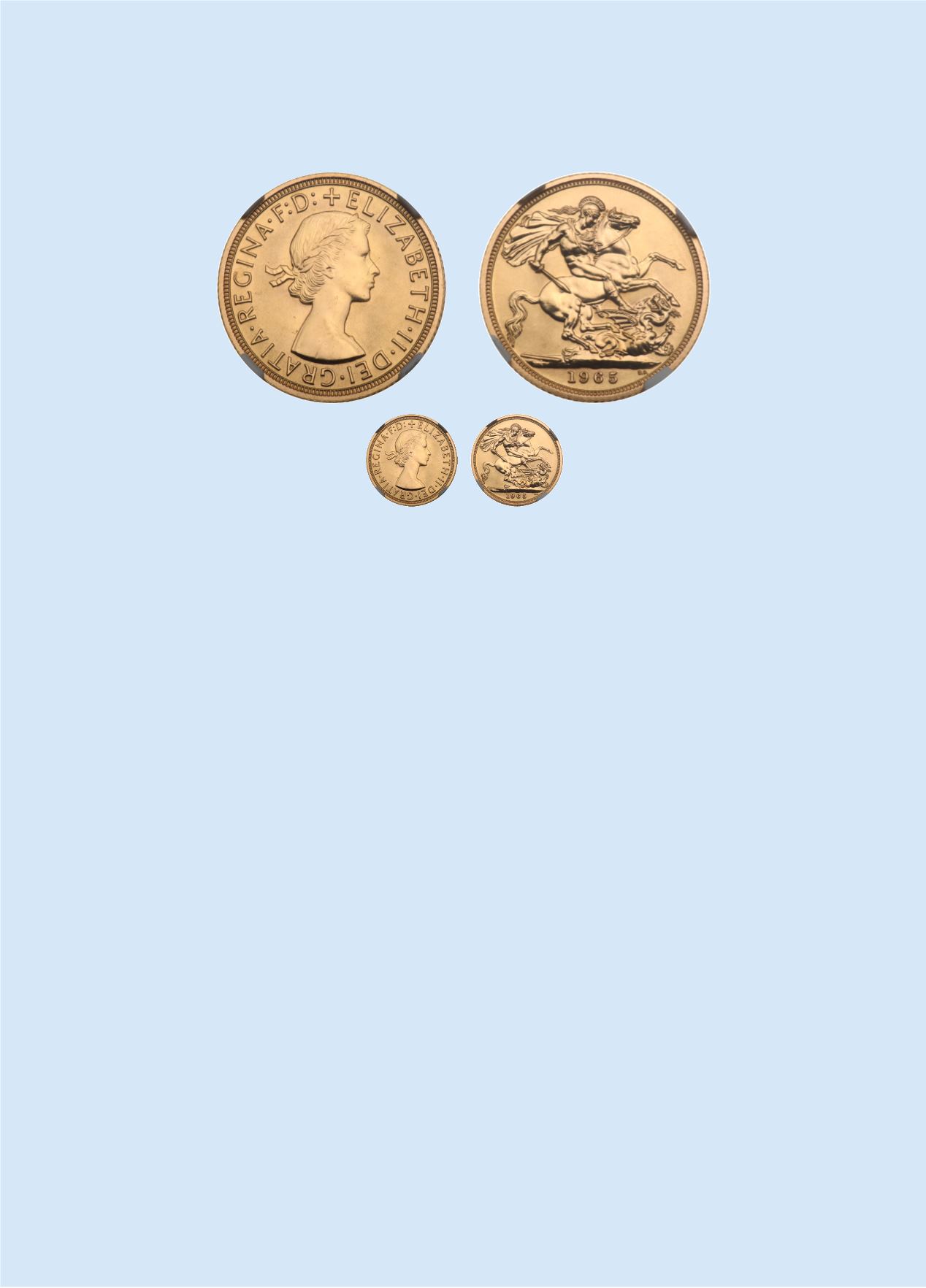

Extremely Rare Satin Proof 1965 Sovereign
1395
Elizabeth II, (1952-). Satin Proof Gold Sovereign, 1965. Designed by Mary Gillick. Portrait facing right
of young Queen Elizabeth. Rev. St. George slaying dragon with sword, tiny B.P. to upper right, date below
exergue. Reeded edge. 7.99 g, 22.2 mm. (S4125 type. KM 908 type). Superb in eye appeal, fully struck,
blemishless high rims, with a lovely vivid-gold color to the silken satiny textured surfaces.
In all a beautiful
specimen of the highest rarity, at least R7 and possibly unique.
NGC graded Satin Proof 64.
$ 65,000
ex Baldwin’s Auction 79, The Bentley Collection (Part 3), May 8, 2013, lot 1237.
ex An Important Collection of Gold Sovereigns 1816-2000, offered as one lot, Sotheby’s, November 2000, Lot 525 (part).
ex Stack’s, New York, June 1, 1997, lot 701.
A mysterious coin, previously unrecognized for what it is, bearing the early, first portrait of Queen Elizabeth II, designed
by Mary Gillick. It is the so-called Second Issue type, as struck from 1957 to 1968 (although in 1957 the edge reeding was
slightly finer, or thinner). The First Issue gold sovereign, dated 1953, had included as part of the royal title the
abbreviated Latin BRITT·OMN; it was struck in brilliant proof for the Coronation but created strictly for museums: it was
never sold to the public. The royal legend was then modified in 1957 to eliminate over-crowding of letters. Proofs of this
so-called Second Issue style occurred only in 1957, 1958, 1959 and 1963, the last date being itself a great rarity made in two
surface types, brilliant and matte. Brilliant proof sovereigns of 1957, 1958 and 1959 appear irregularly for sale. Each date is very
rare and keenly sought after by collectors, but these pale in rarity compared to the proofs of 1953, 1963 and the coin offered here.
The supposition has long been held by numismatists that certain proof gold coins of the 20th century were struck, in
extremely limited numbers, not in brilliant mirror-like format but with non-reflective matte surfaces - entirely for the
purpose of facilitating photographic imaging by and at the Royal Mint. This is the reason normally given for the
existence of the exceedingly rare matte proofs of 1937, which were the first gold coins minted in this format since the matte
proofs of 1902, during the reign of Edward VII. Those 1902 matte-surfaced proofs looked dull at the time, compared to the
brilliant gold proofs of 1887 and 1893, and they proved to be so unpopular with collectors of the day that the Royal Mint
reverted to striking proofs in brilliant reflective format for all subsequent gold coins made for sale to collectors (1911, 1937, and
later issues of 1979 up through today). The only exceptions to such brilliant proofs therefore are these matte pieces intended
for photography. And yet, the coin appearing in the present lot is not matte-like at all. Instead, it displays a gleaming satiny
finish, silky in texture, on each side. Quite obviously, it is not dull and was not made for photographic purposes. What is it, then?
If we look into the history of Britain’s mint, we discover that the decade of the 1960s was a time of experimentation - as well as
of anticipation. Early in 1966, it was announced that a decimal currency system would gradually replace the traditional Pounds,
Shillings, Pence money, starting in February 1971. Then, on April 25, 1967, the Chancellor of the Exchequer formally announced
that the Royal Mint would be moved from its ages-old location near the Tower of London to a Welsh town near Cardiff, where
a modern mint was going to be built. The move had been discussed for more than a decade. A larger facility was needed. A
secure spot outside of London was sought, and finally Llantrisant was decided upon. Thus, in the middle 1960s, a lot of planning
was underway at the mint, and the man in charge was Deputy Master Sir Jack James. He was a decisive man of few words but



















